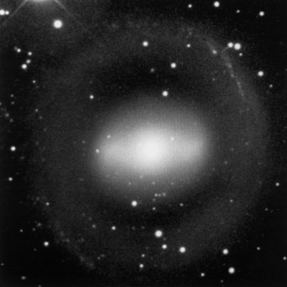
|



2.2. Outer Ring Structures
The rings described in the previous section are called inner rings because they lie in the intermediate zone between the bulge and the spiral arms or disk. Perrine (1922) discovered a second type of ring structure in the southern barred galaxy NGC 1291 that more properly had to be called an ``outer ring'' or an ``external ring''. De Vaucouleurs & Buta (1980b) note that the outer ring of NGC 1291 was already visible on chart 29 of the Franklin-Adams sky charts published in 1910. It is interesting that the outer ring of NGC 7217 is also plainly visible in the photograph in Keeler (1908). In the revised Hubble classification systems described by both Sandage (1961) and de Vaucouleurs (1959a), outer rings are denoted by the symbol (R). De Vaucouleurs commented that such a structure is often observed in lenticulars and early-type spirals but that it is not clearly related to a specific class or family. Later studies (e.g. Kormendy 1979a) have suggested that such rings may be most prevalent in barred galaxies. The relative frequency of the phenomenon seems to be greatest at stage S0/a (de Vaucouleurs 1975a; see section 9.1). Three examples of pure outer rings are illustrated in Figure 1 and Figures 13 - 14. As with inner rings, outer rings are closely linked to the spiral pattern, and occasionally the ring is a wrapped pair of spiral arms that nearly close together. In such cases, the ring is referred to as an outer pseudoring and is symbolized by (R'). Outer pseudorings are discussed in more detail in section 4.1.
The Carnegie Atlas (SB94) emphasizes the connection between outer rings and early-type barred galaxies. In the type sequence they describe for barred S0 galaxies, the bar develops from a barely differentiated oval in the inner regions (type SB01), to a bar of the ``ansae'' type (SB02), to a sharp bar extending across the entire disk (type SB03). SB94 comment that many galaxies classified as type SB02 or SB02/3 have detached or semi-detached outer rings. The interpretation of the features is not always consistent; for example, SB94 classify both NGC 2859 and 4340 as RSB02, yet the ring in the latter is clearly an inner ring filled exactly by the bar.

|